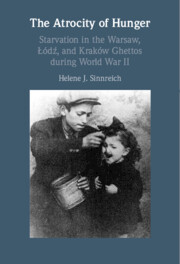‘This is a wonderful book on an important yet understudied topic. Using the themes of food and hunger to analyze everyday life and experience in three Nazi ghettoes, Sinnreich significantly expands our understanding of Jewish experience during the Holocaust. Her careful attention to the symbolic, social, and material functions of food is especially impressive.’
Alice Weinreb - Loyola University Chicago
‘The book explores how socioeconomic status, gender, and religion affected access to food. It also depicts Jewish communal and individual efforts to smuggle, barter, or steal in order to stave off food deprivation. … Highly recommended.’
M. Rice
Source: Choice
‘Sinnreich's book is thoroughly researched and skillfully constructed, effectively achieving her aim to narrate the stories of Jews navigating the challenges of surviving the genocidal famine conditions imposed by Nazi ghettoization. Holocaust scholars, famine researchers, and students exploring everyday life during this period will find Sinnreich's The Atrocity of Hunger to be a valuable resource for deepening our comprehension of Jewish experiences during the Holocaust, particularly in relation to the profound impact of hunger.’
Anne van Mourik
Source: H-Net
‘[An] absorbing, horrifying, and - by thinking broadly about what she terms ‘the atrocity of hunger’ - smartly conceived study worth careful attention, not only for students of the Holocaust but also for those working on famines and mass violence in general. … Sinnreich’s attention to nuance and context makes this book such an important addition to our knowledge about the Holocaust, about hunger and starvation, and about life and death in the ghettos.’
Katrin Paehler
Source: German Studies Review
‘Through victim-centered history of the Jewish experience during the war, this book is an important contribution to both the history of the Holocaust and the diversity of victims’ experiences as well as to the emerging scholarship on genocidal famine. It provides rich insight into the experience of war and in particular its emotive dimensions. Focusing on daily life in three major ghettos in occupied Poland, Sinnreich explores how Jews as individuals, Jewish households, and Jewish communities exercised agency and coped - with variousresults - with hunger … thorough and captivating.’
Katarzyna Person
Source: Yad Vashem


